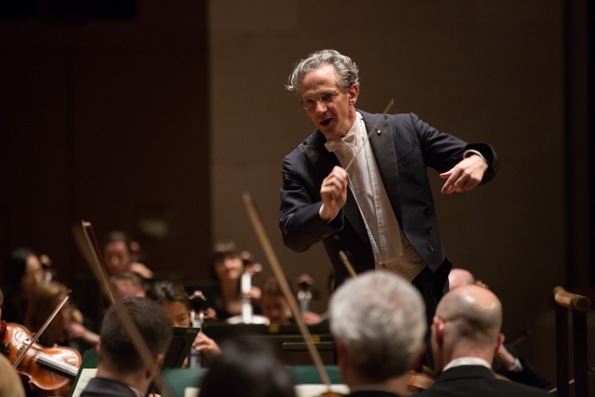Luisi, DSO spin an evening of colorful storytelling, from Copland to Wolfe

Fabio Luisi assembled an evening of works that focus on the art of storytelling for the Dallas Symphony Orchestra’s first program of the new year—a trio of colorful 20th and 21st century works set against Rimsky-Korsakov’s imaginative Scheherezade. Under music director Luisi, Thursday night’s performance at the Meyerson Symphony Center was beautifully executed with a touch of child-like whimsy.
Aaron Copland’s Quiet City was expanded from incidental music he composed for an Irving Shaw play. Copland’s varied influences are manifest in this noirish tone poem for solo trumpet, solo English horn and strings—quintessentially American in its amalgamation of blues progressions and jazz rhythms.
It opens in tonal ambiguity with hushed strings and nervous declarations from the trumpet and English horn (the DSO’s L. Russell Campbell and David Matthews, respectively, playing from their regular seats). Luisi’s balanced textures contributed nicely to the music’s mellow introspection.
DSO composer-in-residence Julia Wolfe’s Fountain of Youth was heard in its Dallas premiere Thursday night. Inspired by the encompassing concepts of youth and vitality, the work was premiered by Michael Tilson Thomas and the New World Symphony in April 2019 in Miami Beach (Florida aptly, the promised land of Ponce de León’s famous quest). Her incorporation of washboards and unconventional performance techniques mirrors the industrial grind of her Anthracite Fields, performed as a part of the DSO’s SOLUNA Festival last year.
Luisi and the DSO showed a marked sympathy for the mood and color of Wolfe’s new piece, with deep, pulsating tremolo strings set against the angsty dissonance of bright horns. Sudden bursts of tango-like percussion from the drum kit offered startling energy, while the bass section slapped their fretboards and ricocheted the backs of their bows off their strings.
This inventive use of metal and wood lifted the percussive element of the score above the dark ominous backdrop provided by the orchestra, resulting in a soundscape that was both playful and intimidating. A welcomed venture into postmodernity, the piece earned the Pulitzer Prize-winning composer a rousing standing ovation from Thursday night’s audience.
Likewise, Samuel Barber’s Andromache’s Farewell offered a boisterous bit of storytelling, with soprano Lise Lindstrom as soloist. Written in 1962, this vocal scena is unmistakably Barber—compact and powerful with an expressive lyrical center—and points the way toward the composer’s opera Antony and Cleopatra, which he would complete four years later. Based on the English text of Euripides’ Trojan Women, it tells of how Andromache, Hector’s widow, must relinquish her son to the conquering Greek army to be executed.
The orchestra opened the piece with a bold four-note expression that would later form the melody of Andromache’s introductory phrase. Lindstrom’s soprano was warm, lamenting, and powerful, requisitely on the dramatic high A’s for which the piece calls. With biting diction and full, well-supported phrasing, her Andromache was dramatic and scornful, matched by the support provided by the orchestra.
The second half of the program featured Rimsky-Korsakov’s Scheherazade. The four-movement symphonic suite is a reimagination of A Thousand and One Nights, an ancient anthology of Arabic, Persian, and Indian tales, within the framework of the Sultana Scheherezade.
Luisi’s sensitivity to the Eastern sensibilities of the score is made evident in the opening of the first movement, where the principal theme of the entire work is introduced in heavy, foreboding octaves. This firm announcement is answered by soothing chords from the winds section before the sinuous voice of Scheherezade is introduced in solo violin. Concertmaster Alexander Kerr executed the solo violin passages expertly throughout, with sensuous legato and impressively accented double stops.
The second movement, titled “The Story of the Kalendar Prince,” features a slew of lovely solo passages in bassoon, oboe and solo horn, each taking the jaunty melody and shifting its color. The orchestra’s well-balanced texture along with Luisi’s astute sense of expression and dynamics made for a compelling read of this movement, so much so that it garnered a premature round of applause from the audience.
The piece moves through varying scenes, conjuring up images of the sea, rousing festivals, and exotic princes and princesses. Themes of romance and adventure are captured through fluttering dance rhythms, dynamic swells and exciting tempo changes, all of which the DSO expertly navigated. The essential storytelling element was palpable throughout, and Fabio Luisi continues to demonstrate a close and growing artistic partnership with the DSO musicians.
The program will be repeated 7:30 p.m. Friday and Saturday and 2 p.m. Sunday. mydso.com, 214-692-0203.


